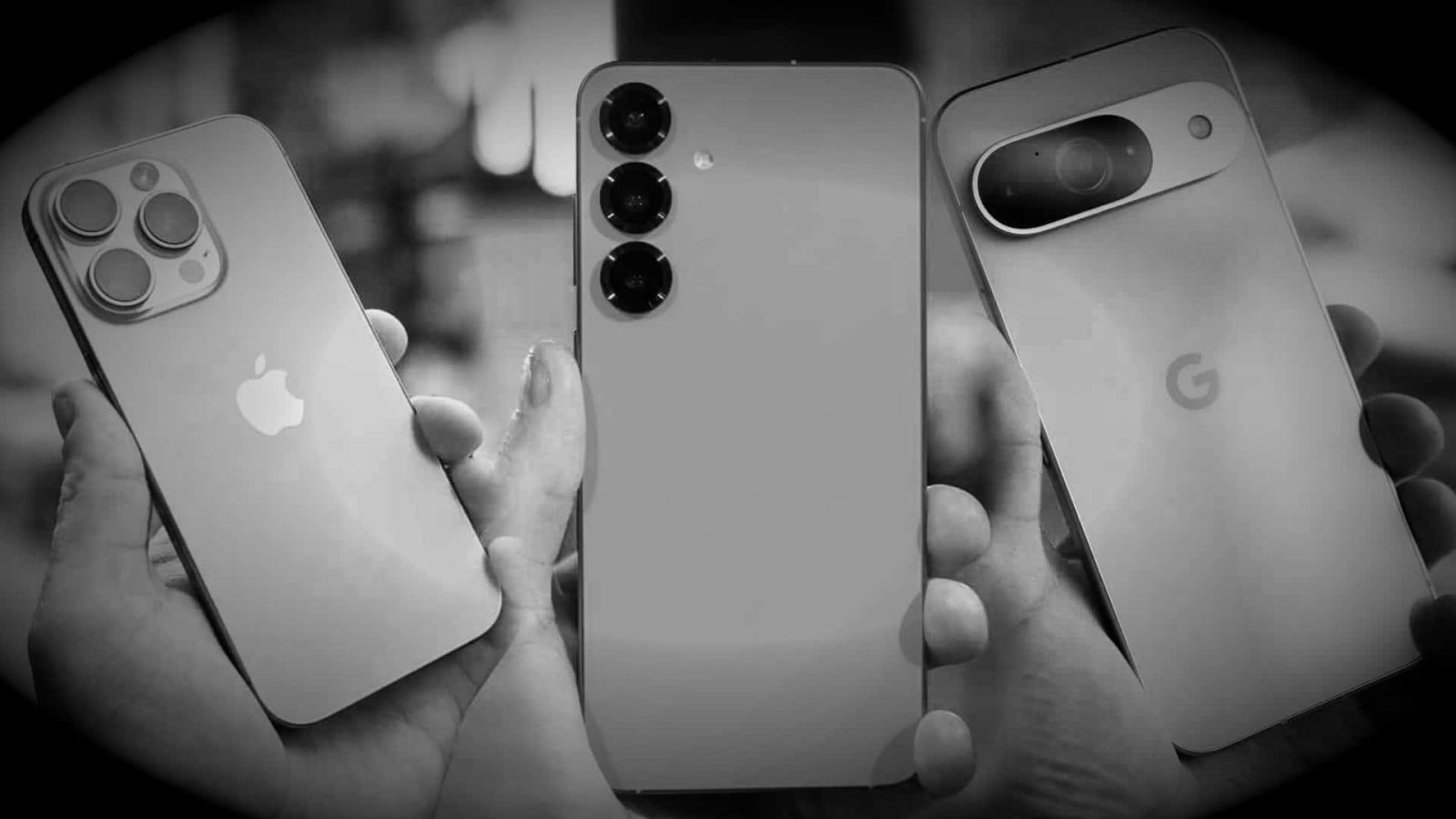
Contents
Apple announced the new iPhone 16e as its affordable entry into the iOS-verse. It comes with some bells and whistles, but it’s ultimately a trimmed-down iPhone 16. Though it’s cheaper than the iPhone 16 proper, it’s not by much. Its $599 price tag doesn’t only make people shudder, but it also reveals a trend in smartphone tech that’s been going on for some time. The fact of the matter is that, with the cheaper versions of phones hitting the market, the base flagship phones are basically useless.
By base flagship phones, we’re referring to phones like the standard Pixel 9, Galaxy S25, iPhone 16, and others. Different phone companies have different flagship lineups, so this won’t apply to EVERY smartphone company out there, obviously. It mostly applies to companies that have a cheaper version of their phones along with flagships.
Base flagships are useless
The mentality of making cheaper versions of a flagship phone has been around for years, and it makes sense. Cheaper phones give people an experience resembling that of the flagship without charging them too much. All the company has to do is make a few cuts here and there to keep the price down, and it has a mid-range juggernaut.
We’ve come to expect this from several brands. Each year, Google releases a Pixel “A” phone, Samsung releases an “FE” phone, Xiaomi releases a “T” phone, and so on. For the past couple of years, OnePlus has been releasing the “R” version of its phones and Apple releases a new affordable phone every couple of years.
These handsets are economical entry points into each OEM’s respective experience, and we’ve come to appreciate their existence. But, here’s the issue, times are different.
The old days
Sure, asking you to remember affordable phones from the mid-2010s is a cruel punishment, but times certainly have changed in the past decade. When a cheaper phone launched years ago, there were major differentiating factors that set it apart from flagships. There are phones like those today, but they were more of the status quo.
A mid-range phone actually felt like a mid-ranger. It gave you an experience that made it clear why it cost less. You wouldn’t see a $300 or $400 phone with a good screen or good performance. At least, you wouldn’t see a phone like that that didn’t come with a OnePlus logo on it. However, things started to shift over the years.
Mid-range chips got better at a faster pace than software, and it got to the point where lower-powered chips could run Android competently. MediaTek boosted its game, and its chips were able to run Android without turning the interface into a slideshow. Cheap phones got better, and it got to the point where we had to bring in the “Flagship Killer” moniker.
Nowadays, things are different
Fast forward to today; companies all around the world are shipping phones with sub-$500 price tags, but they don’t feel like they should be as affordable. It’s a great feeling paying $499 for a phone that makes it feel like you spent $999.
This is the kind of feeling that companies like Google, Apple, and Samsung want to give you with their affordable offerings. The Pixel “A”, Galaxy “FE”, and iPhone “e” (previously “SE”) models give you the feeling of using one of their flagship phones. Buying a Pixel 8a will basically feel like buying a Pixel 8 and picking up a Galaxy S24 FE will fool you into thinking that you bought a Galaxy S24.
It’s great paying sedan money for a sports car, but here’s the issue, these affordable phones are getting less affordable.
Money creep
It’s one thing when a flagship phone rises in price. They’re the expensive models, so it makes sense for them to be expensive. If you don’t like the price, you can always pay for a cheaper phone. No biggie. Again, there are more affordable phones that give you a flagship experience.
However, if a phone’s main selling point is how affordable it is compared to the more premium offerings, what happens when it gets more expensive? That’s a contradiction. If you’re buying a cheaper version of the Pixel 8, and it costs as much as the Pixel 8 proper, what’s the point?
It’s getting to the point where people are saying “You can get the cheaper phone for this much, but you can get the more premium phone for just $200 more.” We’re saying that more and more as time goes on. The iPhone 16e costs $599, but picking up a more capable iPhone 16 costs just $200 more. $200 can be a lot depending on your circumstances, so we don’t want to rule that out. However, you have to think about all of the benefits that extra money will give you.
This isn’t only for Apple’s “affordable” phone. We also say that about the Pixel A phones, which aren’t too far under the flagship Pixel phones in terms of price. Google’s Pixel A phones have been steadily rising in price over the years, so recommending the A series phones become more of a challenge. We also can’t forget about Samsung’s FE phones.
Base flagship phones are useless
One might say that getting rid of these cheaper phones is a good idea because much more capable phones are just a few hundred bucks more. Also, their prices are rising, which negates their core appeal. However, what if the opposite happens?
Base flagship phones sit in this gray area, simultaneously the worst of the best and the best of the worst. Several years ago, when there was a larger divide between flagship and mid-range phones, this wouldn’t have been the case. This is mostly because OEMs would make fewer versions of their devices. They would usually only have that one version of their phone. This one would have all of the bells and whistles; it’d offer the definitive experience while cheaper models would be objectively less premium.
However, flagship lineups are spread out in a smooth gradient, nowadays. We’d see the base, “+”, and Pro (or Ultra) model. The top-tier model would offer the definitive experience, but there would also be the less premium models. The company can slack on these models, as they’re not meant to offer all that the company has to offer.
Another factor was discussed before where cheaper phones and lower-powered chips are getting more powerful. A mid-range MediaTek chip in 2016 and one in 2025 will give you a night-and-day difference.
The line is blurring to the point where you won’t be able to tell the difference between an affordable phone and a base flagship phone.
About that near-flagship experience
Base flagship phones are pretty forgettable, so why are they around? The $500 and $600 affordable phones can do pretty much what the base flagship phones can do. We keep saying that the base flagship phones are just a few hundred more than the affordable phones. But, let’s flip that.
Why pay $800 for a phone when you can save a couple hundred dollars and get a phone that does pretty much the same thing? Sure, there are performance differences in some cases. Samsung hooked its latest FE phone up with a different chip from the Galaxy S24 proper. Even Apple put a watered-down version of its A18 chip in the iPhone 16e. But here’s the thing, cheaper chips have gotten so good nowadays that people won’t be able to tell the difference.
Cheaper chips- not the ones that are the bottom of the barrel- have gotten to the point where they can run Android and iOS flawlessly. Also, they can run intensive apps and dominate graphic-intensive games with no sweat. Most people aren’t going to notice the fact that companies are using less powerful camera sensors.
The average consumer won’t notice the subtle nuances in the performance between an affordable phone and a base flagship. If it’s hard for a tech reviewer to tell the difference, then it’ll be nearly impossible for an average consumer to do so. Rather than having the base flagship phone sitting there without much more to offer, companies should shelf the base flagship phones and keep the affordable phones as the entry points. They offer an experience that’s indistinguishable from the base flagship phones.
But why?
Yes, the base flagship phones do offer more in some areas. Companies hinder their affordable phones for a reason. So, while the experience they offer isn’t all that different from the flagship phones, there are still differences.
But, here’s the thing, the argument for base flagship phones and the argument for affordable phones have changed over the years. Previously, we would argue in favor of getting the flagship phones because they were objectively better. Cheaper phones were cursed with substantially worse screens, weak processors, crappy cameras, and other deplorable specs. “If you want a piss-poor experience, then you pay for a piss-poor experience.”
However, the conversation has pulled a 180. Today, we still sometimes argue in favor of the flagship phone, but the reasons aren’t as substantial. Maybe the flagship’s chip is stronger (on paper), maybe there are more pixels on the screen, or maybe it has a better camera. However, these are things that most people won’t notice.
With how great affordable phones have gotten, it seems that the need to launch base flagships has waned. This is especially true with the state of the global economy. People are more money-conscious. They don’t want to spend more money on something that can give the same experience as something cheaper. It’s more enticing to spend $200 less on a phone and get basically the same experience.
We didn’t plan on this
The whole multiple-variants trend grew gradually over time. While it was developing, companies didn’t anticipate this gradual blurring of the line between affordable and premium phones. At the time, they were worried about providing devices to a wider range of users.
However, the affordable phone trend also developed. The line between lower-end flagships and affordable phones began to thin, as cheaper phones got better. No one could have anticipated it, but it’s the natural progression of tech.
Just like how the phablet market put pressure on the tablet market, the affordable phone could be pushing on the base flagship phone. Who knows how long until we no longer need them at all?
What’s your reaction?
Love0
Sad0
Happy0
Sleepy0
Angry0
Dead0
Wink0






Leave a Reply
View Comments